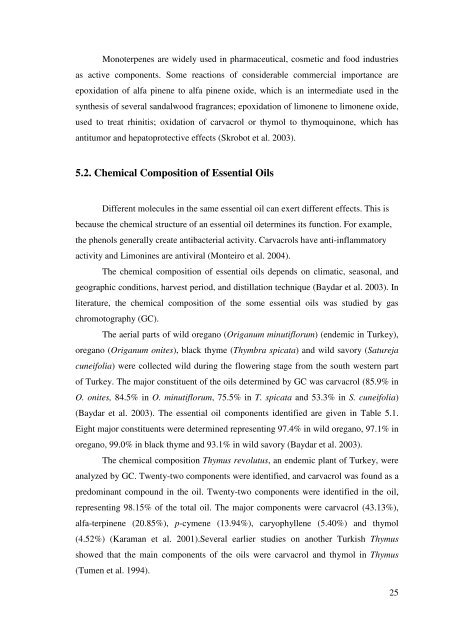the production of thymoquinone from thymol and carvacrol
the production of thymoquinone from thymol and carvacrol
the production of thymoquinone from thymol and carvacrol
You also want an ePaper? Increase the reach of your titles
YUMPU automatically turns print PDFs into web optimized ePapers that Google loves.
Monoterpenes are widely used in pharmaceutical, cosmetic <strong>and</strong> food industries<br />
as active components. Some reactions <strong>of</strong> considerable commercial importance are<br />
epoxidation <strong>of</strong> alfa pinene to alfa pinene oxide, which is an intermediate used in <strong>the</strong><br />
syn<strong>the</strong>sis <strong>of</strong> several s<strong>and</strong>alwood fragrances; epoxidation <strong>of</strong> limonene to limonene oxide,<br />
used to treat rhinitis; oxidation <strong>of</strong> <strong>carvacrol</strong> or <strong>thymol</strong> to <strong>thymoquinone</strong>, which has<br />
antitumor <strong>and</strong> hepatoprotective effects (Skrobot et al. 2003).<br />
5.2. Chemical Composition <strong>of</strong> Essential Oils<br />
Different molecules in <strong>the</strong> same essential oil can exert different effects. This is<br />
because <strong>the</strong> chemical structure <strong>of</strong> an essential oil determines its function. For example,<br />
<strong>the</strong> phenols generally create antibacterial activity. Carvacrols have anti-inflammatory<br />
activity <strong>and</strong> Limonines are antiviral (Monteiro et al. 2004).<br />
The chemical composition <strong>of</strong> essential oils depends on climatic, seasonal, <strong>and</strong><br />
geographic conditions, harvest period, <strong>and</strong> distillation technique (Baydar et al. 2003). In<br />
literature, <strong>the</strong> chemical composition <strong>of</strong> <strong>the</strong> some essential oils was studied by gas<br />
chromotography (GC).<br />
The aerial parts <strong>of</strong> wild oregano (Origanum minutiflorum) (endemic in Turkey),<br />
oregano (Origanum onites), black thyme (Thymbra spicata) <strong>and</strong> wild savory (Satureja<br />
cuneifolia) were collected wild during <strong>the</strong> flowering stage <strong>from</strong> <strong>the</strong> south western part<br />
<strong>of</strong> Turkey. The major constituent <strong>of</strong> <strong>the</strong> oils determined by GC was <strong>carvacrol</strong> (85.9% in<br />
O. onites, 84.5% in O. minutiflorum, 75.5% in T. spicata <strong>and</strong> 53.3% in S. cuneifolia)<br />
(Baydar et al. 2003). The essential oil components identified are given in Table 5.1.<br />
Eight major constituents were determined representing 97.4% in wild oregano, 97.1% in<br />
oregano, 99.0% in black thyme <strong>and</strong> 93.1% in wild savory (Baydar et al. 2003).<br />
The chemical composition Thymus revolutus, an endemic plant <strong>of</strong> Turkey, were<br />
analyzed by GC. Twenty-two components were identified, <strong>and</strong> <strong>carvacrol</strong> was found as a<br />
predominant compound in <strong>the</strong> oil. Twenty-two components were identified in <strong>the</strong> oil,<br />
representing 98.15% <strong>of</strong> <strong>the</strong> total oil. The major components were <strong>carvacrol</strong> (43.13%),<br />
alfa-terpinene (20.85%), p-cymene (13.94%), caryophyllene (5.40%) <strong>and</strong> <strong>thymol</strong><br />
(4.52%) (Karaman et al. 2001).Several earlier studies on ano<strong>the</strong>r Turkish Thymus<br />
showed that <strong>the</strong> main components <strong>of</strong> <strong>the</strong> oils were <strong>carvacrol</strong> <strong>and</strong> <strong>thymol</strong> in Thymus<br />
(Tumen et al. 1994).<br />
25
















